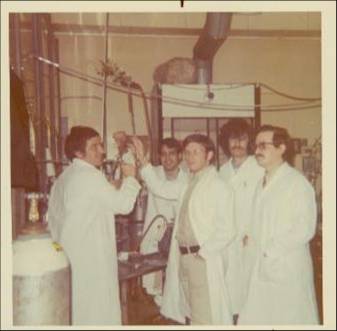|
Time Frame:
2010s |
2000s |
1990s |
1980s |
1970s |
The Early Years
1979
| 1978 | 1977
| 1976 | 1975
| 1974 | 1973
| 1972 | 1971
| 1970
Pictures 1979
|

Four young ChE professors at Purdue: Elias
Franses, Mike Malone (now Dean of Engineering
at the University of Massachusetts), Jim
Caruthers and Nicholas Peppas (Spring 1979)
|
Pictures 1978
|

The blizzard of ’78 in West Lafayette, IN
(October 1978)
|
| |
|

The aftermath of the blizzard of ’78 in
front of the Purdue Union (October 1978)
|
| |
|

One of the earliest pieces of equipment
for the lab was a Plasticorder polymer mixer
used in our polymer plasticizer work (September
1978)
|
| |
|

Our first Instron apparatus for study of
the small deformation mechanical behavior
of hydrogels (March 1978)
|
| |
|

The Andrej Potter building was inaugurated
in 1978. In this new building named after
the Purdue Dean of Engineering of forty
years, Purdue created the first biomedical
engineering program along with independent
laboratories for biomedical and biochemical
engineering. Prof. Peppas was one of the
earliest BME researchers at Purdue and the
co-founder of the BME department. His research
interactions with Prof. Alan Rebar of Veterinary
Medicine led to many ChEs taking histopathology
and other medical courses in VETM. Dr. Rebar
is VP of Purdue now. In the third floor
of this “interdisciplinary engineering building”
we had a laboratory for our artificial kidney
and biomaterials research. (January 1978)
|
Pictures 1977
|

AIChE Meeting, New York. From left: Professor
John O’Connell (now at the University of
Virginia), Nicholas Peppas, Don Mohr (who
did a PhD with Judd King at Berkeley), Professors
GV Reklaitis and D Ramkrishna (in the back,
Professors at Purdue), Steve Burdette (now
with Corning in Corning, NY), Chris Rhodes
(now with UOP in Chicago), Professor KC
Chao (now retired from Purdue), Nancy Henkle-Burgess
(now with Hewlett Packard in Cupertino,
CA) and Mo Sood (then a postdoc of Prof.
Reklaitis) (November 15, 1977)
|
| |
|

Prof Peppas in his office when he was assigned
to teach ChE 529, a course in Organic Chemical
Technology, a course that Norris Shreve
had started 40 years earlier… After Dr.
Shreve's retirement, Prof. Lyle Albright
took the course until the late 70s when
Prof. Peppas was assigned to it and taught
it four times as a modern course on process
technology. As a result of this course,
he received the first of three Engineering-wide
Potter teaching awards.
|
Pictures 1976
|

A differential scanning calorimeter (Perkin
Elmer DSC-1B) was the first equipment of
the Peppas laboratory purchased in October
1976 with $10,500 start-up funds! These
were the only start-up funds given at that
time. Remodedling of CMET 210 took one year
to be completed!
|
| |
|

First month at Purdue University. The Engineering
complex (September 1976)
|
| |
|

July 4, 1976 (bicentennial) in Boston
Back row (from left): Nicholas Peppas, Pepi
Klouda, Nanta Papazoglou holding the young
Alexander Georgakis, Tina Georgaki, Mihalis
Fardis (now Professor of Civil Engineering,
University of Patras, Greece), Tonia Fardi.
Front row: Vassilis Papazoglou (now Professor
of Naval Engineering, National Technical
University, Athens, Greece), and Christos
Georgakis (now Professor of Chemical Engineering,
Tufts University, Medford, MA)
|
| |
|

Students and collaborators of the Arteriosclerosis
Center of MIT including Bernie Cusack, a
lab manager in the Arteriosclerosis Center,
Carlos Ramirez (center right, then a PhD
student at MIT, now a Professor of Chemical
Engineering at the University of Puerto
Rico at Mayagüez) and Larry Feig (then a
MS student at MIT, now a Professor of Biochemistry
at Tufts University in Medford, MA). In
those days the Arteriosclerosis Center of
MIT was a major research center. Chemical
engineers such as professors Ken Smith and
Clark Colton were associated with the Center.
It was also during those days that Professor
Peppas met Prof. Bob Nerem (see photographs
of 2006) who was a young professor at Ohio
State University and was working on arteriosclerosis
as well. Graduate students and postdocs
who passed through the laboratory in those
days including Jay Scnhitzer (now Professor
at Harvard Medical School), Carlos Ramirez
(now a Professor of Chemical Engineering
at the University of Puerto Rico at Mayagüez), Alan Glombicki, then a ChE undergraduate student, now Professor of Internal Medicine at the University of Texas Health Sciences Center in Houston),
Guy Chisolm (now a Professor of Biomedical
Engineering at the Case Western Reserve
University), Bob Bratzler (later Professor
of Chemical Engineering at Princeton and
now a senior consultant in Boston), Rena
Bizios (now Professor of Bioengineering
at the University of Texas at San Antonio)
and George Truskey (now Head of Biomedical
Engineering at Duke University). (February
1976)
|
| |
|

Nicholas Peppas holds a biocompatible poly(vinyl
alcohol) membrane developed during his PhD
thesis at MIT. However, it was 2 1/2 years
later, in 1976, that the first work on the
biocompatibility of PVA was published, work
that attracted wide scientific interest
both in the professional and popular press
(January 1976)
|
Pictures 1975
|

Peppas as a postdoctoral fellow at the Arteriosclerosis
Center of MIT. It was during this period
at MIT that Nicholas got involved seriously
in biomedical engineering. (October 1975)
|
| |
|

Cape Cod, Massachusetts
From left: Dr. Petros Antonopoulos (MIT
nuclear engineer, now practicing engineer
in Boston), Dr Stavros Anagnostopoulos (MIT
civil engineer, now Professor at the University
of Patras, Greece), Professor Elias Gyftopoulos
(MIT, Dept of Nuclear Engineering, now Professor
Emeritus at MIT), and Nicholas Peppas. Sitting:
Dr Ioannis Constantopoulos (MIT, civil engineer,
now practicing engineer in Athens, Greece)
(September 1975)
|
| |
|

Nicholas Peppas (very top, left, leaning
towards the blackboard) as a postdoctoral
fellow in the Arteriosclerosis center of
MIT of Prof Robert Lees.
Among others, Alan Glombicki, then a ChE undergraduate student (in front and to the right of N Peppas, now Professor of Internal Medicine at the University of Texas Health Sciences Center in Houston), Larry Feig (just in front
of N Peppas, now Professor of Biochemistry
at Tufts University), Rena Bizios (left
of L Feig, now Professor of Bioengineering
at the University of Texas at San Antonio),
Jay Schnitzer (left and behind Rena Bizios,
now Professor of Surgery at the Harvard
Medical School) and Guy Chisolm (next to
Jay Schnitzer, now Vice Chairman of the
Lerner Research Institute at the Cleveland
Clinic) (June 1975)
|
Pictures 1974
|

Nicholas Peppas served in the Greek Army. At graduation as a second Lieutenant in the School of Officers of the Ordnance Corps of the Greek Army and the leader of his class, he is addressed by general Galathianakis. Lamia, Greece, August 1974
|
| |
|

Peppas (right) at the Ordnance Corps School
for Officers of the Greek Army in Lamia,
Greece. Military service is a requirement
in Greece (August 1974)
|
| |
|

Dr Nicholas Peppas served in the Greek Army.
He graduated as a second Lieutenant in the
School of Officers of the Ordnance Corps
of the Greek Army. As the leader of his
class, he represented his class of officers
at the graduation ceremony in Lamia, Greece
in August 1974
|
Pictures 1973
|

Peppas sailing at Charles River (MIT, Cambridge,
MA) as a graduate student (April 1973)
|
| |
|

The first paper of Prof Peppas. It was published
in the AIChE Journal and reported results
of his studies on the thermodynamics of
multivalent polyelectrolytes. This was the
result of work he had done under the supervision
of Prof. Herman “Fritz” Meissner while he
was a teaching assistant in the spring 1972!
Fritz Meissner was Peppas’ academic grandfather
as he was the supervisor of Prof Merrill
in 1945-47. The paper shown here is part
of a series of papers published on this
subject by Fritz Meissner and his then graduate
students including C Cusik and Jeff Tester,
now an MIT ChE professor.
|
Pictures 1972
|

Nicholas Peppas as a second year graduate
student in Ed Merrill MIT laboratories of
biomaterials. The samples in the jars are
semicrystalline poly(vinyl alcohol) gels.
(December 1972)
|
| |
|

At the MIT Biomaterials Laboratories of
Prof. Edward Merrill
From left: Steve Rose (now in Miami), Hossein
Banijamali (now with Canadian Petroleum
Processing, Inc.), Tim Burke (now with ExxonMobil),
Michael Sefton (now University Professor
at the Univ of Toronto) and Nicholas Peppas
(May 1972)
|
| |
|

The MIT Cobalt-60 (gamma irradiation unit)
was the only equipment in the small building
called E-66 in the 1950s-70s. The building
was demolished at the end of 1972 and became
the site of the new Chemical Engineering
building (named again E66) that was inaugurated
two years later… (March 1972)
|
Pictures 1971
|

The MIT electron beam irradiation unit at
the Van de Graaf generator laboratory (December
1971)
|
Pictures 1970
|

IAESTE internship at the Shell company in
Pernis, Rotterdam, the Netherlands
Here, Nicholas Peppas (right) with NTU Athens
classmate Costas Lamnatos (left, now Director
Ferronikeli Complex L.L.C.) in an outing
in the canals of Rotterdam. The movie theater
was playing MASH that had just started showing
in Europe (July 1970)
|
|
